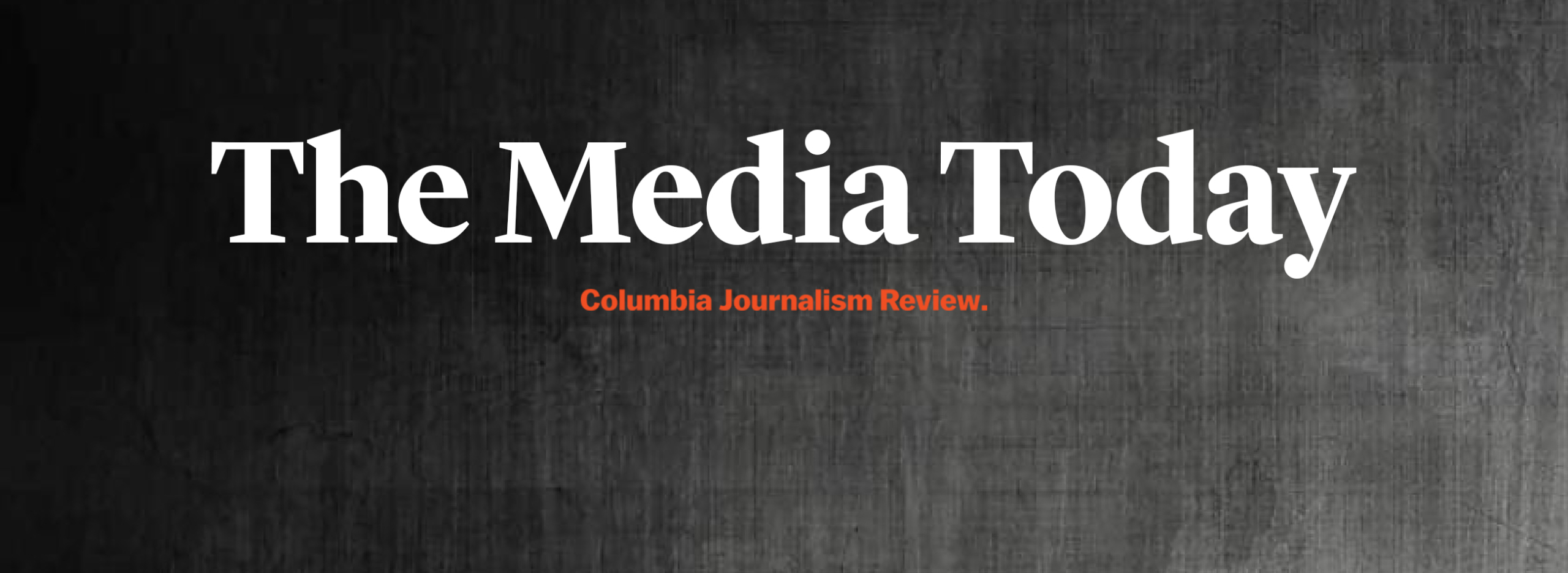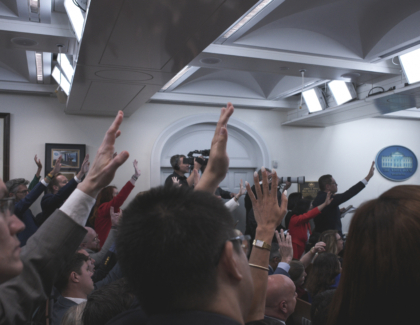Sign up for the daily CJR newsletter.
Last week, Margaret Sullivan, a media critic at the Washington Post, argued that we need to get the “Fox News monster” under control. “I do not believe the government should have any role in regulating what can and can’t be said on the air, although I often hear that proposed. That would be a cure worse than the disease,” she wrote. “But let’s not count on the hope that the Fox-controlling Murdochs will develop a conscience. No, the only answer is to speak the language that the bigwigs at Fox will understand: Ratings. Advertising dollars. Profit.” Major advertisers, she wrote, should abandon Fox. Consumers should pressure them to do so.
Her column was an answer to a broader question that has occupied media circles since the election disinformation pushed by Donald Trump and his propagandists triggered the insurrection of January 6: what steps need to be taken to hold the perpetrators to account, and fix America’s broken, lie-drenched information ecosystem? Sullivan’s hasn’t been the only suggestion to target Fox and other Trump-friendly outlets like Newsmax and One America News. Various commentators have argued that—since ad boycotts haven’t typically worked in the past, and, in Fox’s case, leave the bulk of its revenue untouched—it would be more effective to put pressure on the TV providers that carry such networks into viewers’ homes; the providers, this argument goes, should simply drop channels that peddle lies, or at least give customers the option not to pay for them as part of their package. “Surely, these companies—many of which boast about their social and civic responsibilities—have limits to the content they disseminate,” CNN’s Oliver Darcy wrote in the aftermath of the insurrection. “It’s hard, for instance, to imagine they’d carry a fringe and conspiratorial network like InfoWars.” (Darcy asked major TV providers for more information on their standards; for this act of journalism, Fox’s Tucker Carlson accused CNN of lobbying to have Fox “censored.”)
Podcast: GameStop, Reddit, and who hacked the system
But the provider push, like the ad-boycott suggestion, is complicated. As Bloomberg’s Gerry Smith reported recently, there are a number of reasons why providers can’t just drop networks: contractual agreements, for starters, and—in the case of AT&T and Comcast, which own CNN and NBCUniversal, respectively—competition rules enforced by the Federal Communications Commission. Under so-called “leased-access laws,” providers must carry independent channels—a category that would include both Newsmax and OAN—if they agree to pay providers to be included (rather than the other way around). Even if a TV provider could exercise editorial discretion, Smith writes, doing so could cause a costly PR and legal headache; if Comcast, for instance, tried to drop Fox News, Fox could retaliate by pulling its sports programming, for instance, from Comcast, which would irk many Comcast customers. Even advocates of “crushing Fox”—as Kevin Drum, a blogger at Mother Jones, put it recently—acknowledge that the provider-pressure strategy won’t work. Drum’s alternative suggestion? A mass boycott of a major Fox advertiser. And so the circle goes on.
Another idea that has circulated widely recently is bringing back the Fairness Doctrine, an FCC rule, implemented in 1949 but crushed by the Reagan administration and its allies in the late eighties, that mandated balanced coverage of political controversies on TV and radio. Victor Pickard, a professor of media policy and political economy at the University of Pennsylvania who has researched the doctrine, wrote recently that it merits consideration in the present debate—he called the doctrine “an imperfect but legitimate attempt to prevent predictable biases that emerge in highly commercialized media systems that tend toward monopoly control,” and noted that its abolition was a key factor in the subsequent “explosion of right-wing radio programming.” Fox followed soon after. Writing for CNN last week, however, Nicole Hemmer, a historian of conservative media and scholar at Columbia, shared a different perspective—pointing out that many conservatives actually favored the doctrine, which they saw as an opportunity to challenge liberal ideas. If the doctrine were renewed today, she warned, it could easily be used “to spread right-wing propaganda further: to argue, for instance, that someone challenging the 2020 presidential election results should appear on every newscast, or that climate change deniers receive airtime in every discussion of the climate crisis.”
Hemmer noted that the Fairness Doctrine “emerged in a time when the central concern was the scarcity of platforms,” whereas “now, misinformation and disinformation flourish in an environment of abundance”; tackling that environment, she wrote, requires disincentivizing disinformation across a range of broadcast and online platforms, including social media. The insurrection led major platforms to, belatedly, take aggressive actions to clamp down on viral lies and incitements to violence; Twitter, for instance, removed tens of thousands of accounts, up to and including that of Trump himself, and Facebook booted Trump, too. The research company Zignal Labs found that the prevalence of election lies on social media declined by nearly seventy-five percent in the week that followed the Trump bans, but such retroactive enforcement actions are only a short-term fix—as Kate Starbird, a researcher at the University of Washington, pointed out to the Post, “What happens in the long term is still up in the air.” Major platforms’ core algorithms are, rightly, attracting renewed scrutiny: last week, Mark Zuckerberg, Facebook’s CEO, said that the company was looking into reducing the amount of political content in users’ feeds; yesterday, Jeff Horwitz, of the Wall Street Journal, reported that Facebook is also clamping down on groups after its own research found them to be a key vector of “rabid partisanship,” lies, and calls for violence linked to the election. (In theory, this marks the extension of temporary, pre-election steps that Facebook said it took to stop steering users to join political groups—though The Markup has reported that in practice, the steering didn’t stop.)
The reason these debates can feel circular, of course, is that there are no easy answers. The best thing we can do in this moment of reckoning is, perhaps, to widen the circle—by promoting a nuanced understanding of the information ecosystem that sees notions of “free speech” and “censorship” as tradeoffs; that treats the wielding of corrosive lies, never mind physical insurrection, as a threat to free expression, as well as its exercise; that speaks to all levels of power, from the individual news consumer to the Silicon Valley executive suite; and that keeps all potential fixes in the conversation, even if they involve taboo topics like government intervention. As Pickard put it recently, what we are dealing with, ultimately, is the “dangerous concentration of unaccountable media power.” If nothing else, he wrote, “recent events should cause us to reexamine our assumptions about relationships between the First Amendment, corporate power, content regulation, and democracy.”
Below, more on the information ecosystem:
- Speech v. reach: Yesterday, Brian Stelter, CNN’s chief media correspondent, also addressed the state of our information climate on his show, Reliable Sources. “Reducing a liar’s reach is not the same as censoring freedom of speech… and algorithmic reach is part of the problem,” he said, with reference to social-media platforms. He also took aim at the lies being spread on right-wing TV. “It’s impossible to make all those lies go away,” Stelter said. “But they can be reduced.”
- Helping your loved ones: Over the weekend, NPR’s Sarah McCammon spoke with people whose loved ones have fallen prey to disinformation, and asked experts what such people can do to help weaken its grip. James Hawdon, director of the Center for Peace Studies and Violence Prevention at Virginia Tech, “advises pushing back kindly—and trying to understand what led to that belief.” Deen Freelon, an associate journalism professor at the University of North Carolina at Chapel Hill, “says a heavier hand is necessary in some situations.”
- More on the Trump bans: Last week, my CJR colleague Mathew Ingram convened a series of conversations on Galley, our discussion platform, on the issues raised by the recent deplatforming of Trump. Jillian York, of the Electronic Frontier Foundation; Ethan Zuckerman, of the Institute for Digital Public Infrastructure; Evelyn Douek, of Harvard; Jessica Gonzalez, of Free Press; Ben Smith, media columnist at the Times; Dipayan Ghosh, of the Digital Platforms and Democracy Project; Yael Eisenstat, of Cornell; and Benedict Evans, an independent analyst, weighed in. You can find their insights here.
- Section 230: Kashmir Hill, of the Times, tells the astonishing story of a woman in Canada who used various online portals to sow “outrageous lies” about people she perceived as having slighted her—including Hill, her husband, and her editor. “Many of the victims have tried to get tech companies to remove the abusive posts,” Hill writes, but have run into legal impediments including Section 230 of the Communications Decency Act, an increasingly-controversial US statute that shields platforms from liability for users’ posts.
Other notable stories:
- On CJR’s podcast, The Kicker, Kyle Pope, our editor and publisher, discussed media coverage of the GameStop story, and of Wall Street generally, with Amber Jamieson, of BuzzFeed News. “There are so many people who have never had the information or knowledge or understanding of how to buy and sell and trade stocks,” Jamieson said. “It is not taught in schools. Every financial publication doesn’t explain it. There are so few ways that an ordinary person can learn about it.” Elsewhere, the New Republic’s Alex Shephard writes that the GameStop story has revealed whose interests financial media really serve: “These networks are all about upholding the sanctity of the Blessed Market and protecting the interests of their high-faluting financial sector guests,” he writes.
- Hans Nichols, of Axios, assesses the White House’s comms strategy: ignore Twitter outrage, limit access to Biden, and, increasingly, bypass national media by speaking to local reporters. (Last week, Vice President Kamala Harris gave interviews to outlets in Arizona and West Virginia; the latter irked the state’s Democratic senator, Joe Manchin.) “The White House controlled the narrative for the first twelve days,” Nichols writes, but knows that it “must be innovative as the press corps steps up its independent scrutiny.” (One innovation: Jen Psaki, the press secretary, went on Wait Wait…Don’t Tell Me!.)
- HD Media, which owns the Charleston Gazette-Mail and other papers in West Virginia, is suing Google and Facebook, alleging that the tech giants’ duopoly in the online advertising market is “strangling a primary source of revenue for newspapers across the country.” HD Media says it’s the first newspaper publisher to file such a suit, though the magazines The Nation and The Progressive are also suing Google on antitrust grounds.
- Last week, the New Jersey Hills Media Group, which owns fourteen weekly papers across four New Jersey counties, announced that it will seek nonprofit status. The group will work on its transition with the Corporation for New Jersey Local Media, a nonprofit focused on sustainability for local news; according to Editor & Publisher, the groups hope their collaboration will “serve as a paradigm” for newspaper chains nationwide.
- Overnight, the military in Myanmar staged a coup, wresting power from the civilian government led by Aung San Suu Kyi, who has been detained alongside her top deputies. State TV and radio reportedly went down, internet access has been sporadically curtailed, and, according to the Times, some local journalists have gone into hiding, “for fear that their reporting could compromise their safety.” Reuters has more.
- For the second weekend in a row, tens of thousands of Russians took to the streets in solidarity with Alexei Navalny, the country’s jailed opposition leader, and the authorities responded with mass arrests. More than five-thousand people were detained, including, Meduza reports, more than eighty journalists. CNN’s Frederik Pleitgen was among those swept up; he was released, he says, when police realized that he was a foreign reporter.
- In his newsletter, Riyadh Bureau, Ahmed Al Omran explores the dynamic between the Saudi regime and local papers that are struggling financially and asking for a bailout. “The margin for freedom of expression has been rapidly shrinking,” Al Omran writes. “This is reflected in the local press. Rarely subversive or seeking to hold the government accountable in the past, it has increasingly become more docile and obedient.”
- On his new podcast, Jack Blanchard, who, until recently, wrote the London edition of Politico’s Playbook newsletter, asks whether the explosion of that and other insider daily briefings—a model Britain imported from the US—has been good for journalism. At their worst, he says, such newsletters can be “elitist, cliquey, and amoral”; at their best, they explain politics “to insiders and outsiders alike—accurately, in detail, and in real time.”
- And Mary-Kay Wilmers, who co-founded the London Review of Books in 1979 and has served as its editor since 1988, is retiring from the role. Jean McNicol and Alice Spawls, both senior editors at the Review, will jointly succeed Wilmers, who plans to stay on as a consulting editor. The Guardian’s Alison Flood has more on Wilmers’s tenure.
ICYMI: Warning signs from the Biden-Trump split screen
Has America ever needed a media defender more than now? Help us by joining CJR today.







